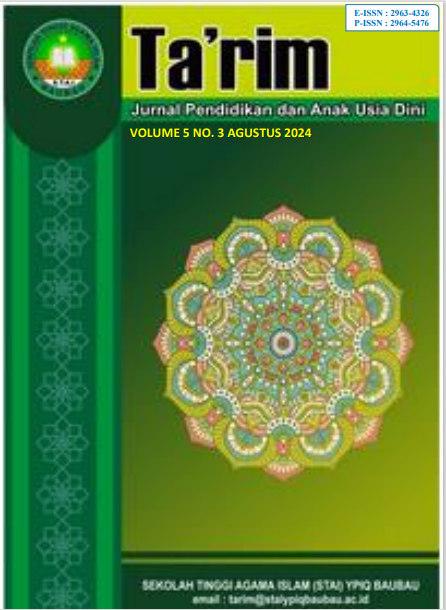Analisis Analisis Perilaku Agresif Kelompok A Kota Pontianak
DOI:
https://doi.org/10.59059/tarim.v5i4.1959Keywords:
Aggressive, Behavior, Barriers, Early Childhood, HandlingAbstract
This study examines aggressive behavior in early childhood at Aisyiyah Bustanul Athfal 3 Pontianak. The study aimed to provide a comprehensive picture of the forms of aggressive behavior exhibited by group A children, analyze the handling strategies applied by teachers, and identify barriers in overcoming these behaviors. Using a qualitative approach with a case study method, data were collected through observation, interviews, and documentation. The research subjects were group A children at Aisyiyah Bustanul Athfal 3. Data analysis was conducted using data reduction, data presentation, and conclusion drawing techniques. The results showed that physical aggressive behavior was the most commonly observed form of aggression with a percentage of “Ever” occurrence of 17.11%. Verbal and relational aggression are also significant although not as high as physical aggression. The treatment strategies applied include behavioristic, cognitive, humanistic, and collaboration with parents. The research highlights the importance of the right approach in addressing aggressive behavior in early childhood. The main barriers include limited teacher understanding, inconsistency between school and home, and lack of parental support. Collaborative efforts from various parties are needed to effectively address these barriers.
References
Arriani, F. (2014). Perilaku agresif anak usia dini. Jurnal Pendidikan Usia Dini, 8(2), 269-280.
Bandura, A. (1973). Aggression: A social learning analysis. Prentice-Hall.
Broidy, L. M., Nagin, D. S., Tremblay, R. E., Bates, J. E., Brame, B., Dodge, K. A., ... & Vitaro, F. (2003). Developmental trajectories of childhood disruptive behaviors and adolescent delinquency: A six-site, cross-national study. Developmental Psychology, 39(2), 222-245.
Buss, A. H., & Perry, M. (1992). The aggression questionnaire. Journal of Personality and Social Psychology, 63(3), 452-459.
Creswell, J. W. (2014). Research design: Qualitative, quantitative, and mixed methods approaches (4th ed.). Sage Publications.
Denzin, N. K. (1970). The Research Act: A Theoretical Introduction to Sociological Methods. Aldine.
Dodge, K. A., & Coie, J. D. (1987). Social-information-processing factors in reactive and proactive aggression in children's peer groups. Journal of Personality and Social Psychology, 53(6), 1146-1158.
Domitrovich, C. E., Cortes, R. C., & Greenberg, M. T. (2007). Improving young children's social and emotional competence: A randomized trial of the preschool "PATHS" curriculum. The Journal of Primary Prevention, 28(2), 67-91.
Izzaty, R. E. (2005). Mengenal Permasalahan Perkembangan Anak Usia TK. Jakarta: Departemen Pendidikan Nasional.
Kurniah, N., Andreswari, D., & Kusumah, R. G. T. (2019). Achievement of development on early childhood based on national education standard. In Proceedings of the International Conference on Educational Sciences and Teacher Profession (ICETeP 2018) (pp. 351-354). Atlantis Press.
Ladd, G. W., & Burgess, K. B. (1999). Charting the relationship trajectories of aggressive, withdrawn, and aggressive/withdrawn children during early grade school. Child Development, 70(4), 910-929.
Lincoln, Y. S., & Guba, E. G. (1985). Naturalistic Inquiry. SAGE Publications.
Mastuinda, M., & Suryana, D. (2021). Perilaku agresif anak usia dini. Jurnal Riset Golden Age PAUD UHO, 4(1), 1-8.
Miles, M. B., Huberman, A. M., & Saldana, J. (2014). Qualitative data analysis: A methods sourcebook (3rd ed.). Sage Publications.
Myers, D. G. (2012). Social psychology (11th ed.). McGraw-Hill.
Novita, E. (2012). Perbedaan agresivitas ditinjau dari pola asuh orang tua. Jurnal Analitika, 4(2), 53-60.
Pratiwi, D. F. (2019). Hubungan antara kecerdasan emosi dengan perilaku agresif remaja. Jurnal Psikologi, 15(2), 80-86.
Santrock, J. W. (2011). Child development (13th ed.). McGraw-Hill.
Siahaan, Y. E., Sutapa, P., & Yus, A. (2020). Pengaruh komunikasi orangtua terhadap perilaku agresif verbal anak usia 5-6 tahun. Jurnal Obsesi: Jurnal Pendidikan Anak Usia Dini, 5(2), 1472-1486.
Solichah, N. (2020). Storytelling untuk mengatasi perilaku agresif anak. Al-Qalb: Jurnal Psikologi Islam, 11(2), 1–12.
Sugiyono. (2017). Metode penelitian kualitatif. Alfabeta.
Suryana, D. (2016). Pendidikan Anak Usia Dini: Stimulasi & Aspek Perkembangan Anak. Prenada Media.
Susantyo, B. (2011). Memahami perilaku agresif: Sebuah tinjauan konseptual. Informasi, 16(03), 189-202.
Tremblay, R. E. (2000). The development of aggressive behaviour during childhood: What have we learned in the past century. International Journal of Behavioral Development, 24(2), 129-141.
Triwahyuni, E. (2018). Penanganan perilaku agresif pada anak usia dini. Jurnal Pendidikan Anak, 7(2), 165-174.
Webster‐Stratton, C., & Hammond, M. (1997). Treating children with early‐onset conduct problems: A comparison of child and parent training interventions. Journal of Consulting and Clinical Psychology, 65(1), 93-109.
Wiyani, N. A. (2014). Psikologi perkembangan anak usia dini. Gava Media.
Zimmerman, B. J., & Schunk, D. H. (Eds.). (2003). Educational psychology: A century of contributions. Routledge.
Downloads
Published
How to Cite
Issue
Section
License
Copyright (c) 2024 Ta'rim: Jurnal Pendidikan dan Anak Usia Dini

This work is licensed under a Creative Commons Attribution-ShareAlike 4.0 International License.








